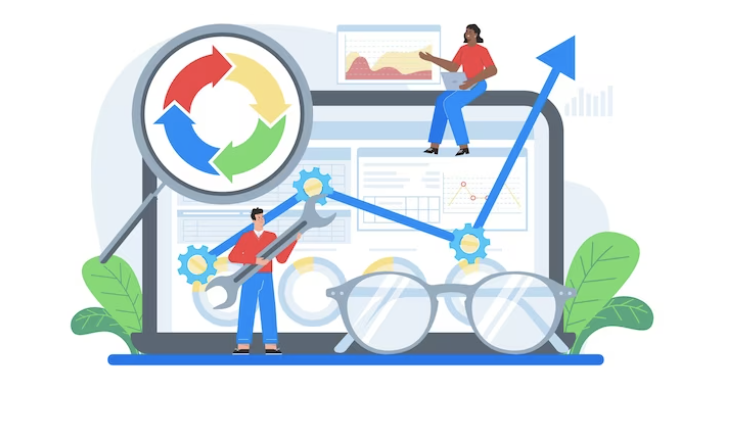Introduction
DevOps stands as a powerful force that is reshaping the way organizations conceive, develop, and deliver software solutions. Whether you’re an aspiring IT professional eager to embark on your DevOps journey or a curious newcomer looking to decode the buzz around this transformative approach, you’ve arrived at the perfect starting point. In this DevOps guide, we’ll embark on a comprehensive exploration of DevOps, peeling back the layers to uncover its essence, significance, and practical applications in the United States. This journey will demystify DevOps, making it accessible and understandable for beginners. We’ll cover everything from its fundamental principles to the practical tools that empower DevOps practices, and we’ll provide you with the guidance and resources needed to begin your own DevOps adventure.
The Origins of DevOps

DevOps is a fusion of two words: “Development” (Dev) and “Operations” (Ops). It represents a collaborative approach to software development and IT operations aimed at shortening development cycles, improving software quality, and accelerating the release of new features and updates. To understand DevOps, it’s crucial to explore its origins. DevOps emerged as a response to the challenges posed by traditional software development and IT operations processes. It brings together concepts from Agile, Lean, and other methodologies to create a more efficient and collaborative workflow.
Key Principles of DevOps
DevOps principles guide its implementation:
Collaboration:
DevOps fosters collaboration between development and operations teams, breaking down silos and encouraging shared responsibility.Automation:
Automation is a cornerstone of DevOps, streamlining repetitive tasks and ensuring consistency in processes.Continuous Integration:
CI involves regularly merging code changes into a shared repository, allowing for faster error detection and integration.Continuous Delivery:
CD extends CI by automatically deploying code to production-like environments, enabling rapid and reliable releases.Monitoring and Feedback:
DevOps emphasizes continuous monitoring of applications and infrastructure, enabling rapid response to issues.
Now that we’ve covered the basics, let’s move on to understanding the DevOps lifecycle.
The DevOps Lifecycle

The DevOps Pipeline
Imagine DevOps as a continuous pipeline that consists of several stages, from planning and development to monitoring and feedback. Each stage plays a crucial role in ensuring smooth software delivery.Planning and Development
This phase involves defining project goals, planning tasks, and creating code. DevOps encourages early collaboration between developers and operations teams to ensure that infrastructure needs are considered from the start.Continuous Integration (CI)
CI is the practice of frequently merging code changes into a shared repository, where automated tests are run to catch issues early. This promotes code quality and collaboration.Continuous Delivery and Deployment (CD)
CD takes CI a step further by automatically deploying code changes to production-like environments. Continuous Deployment goes one step further, automatically pushing changes to production. These practices ensure that new features and bug fixes are swiftly and reliably delivered to users.Monitoring and Feedback
Monitoring applications and infrastructure is vital for detecting and addressing issues in real-time. Feedback from monitoring helps teams make data-driven decisions to enhance the user experience and system reliability.Continuous Improvement
DevOps doesn’t stop with deployment. It embraces a culture of continuous improvement, where teams regularly assess processes and seek ways to optimize efficiency, quality, and performance.
Also read: Top DevOps service companies in San Francisco, USA
Tools of the Trade

Introduction to DevOps Tools
DevOps relies on a rich ecosystem of tools to streamline processes and promote collaboration. These tools can be categorized into several key areas:
Source Code Management (SCM) Tools
SCM tools, such as Git and GitHub, enable version control, allowing teams to track changes, collaborate on code, and manage codebase history efficiently.CI/CD Tools
Continuous Integration and Continuous Deployment tools, like Jenkins, Travis CI, and CircleCI, automate the build and deployment processes, ensuring that code changes are continuously integrated, tested, and delivered to production.Containerization and Orchestration Tools
Containerization tools like Docker and container orchestration platforms like Kubernetes provide a standardized way to package and manage applications, making them portable and scalable across different environments.Infrastructure as Code (IaC) Tools
IaC tools like Terraform and AWS CloudFormation allow infrastructure provisioning to be codified, enabling consistent and repeatable deployments while reducing manual configuration errors.Monitoring and Logging Tools
Tools like Prometheus, Grafana, and ELK Stack facilitate real-time monitoring, logging, and alerting, providing insights into application and infrastructure performance.
Building a DevOps Culture

The Role of Culture in DevOps
Culture plays a pivotal role in successful DevOps adoption. A DevOps culture values collaboration, transparency, and a focus on delivering value to customers.Breaking Down Silos
DevOps encourages breaking down silos between development, operations, and other teams. Communication and shared goals become the norm, leading to better collaboration.Collaboration and Communication
Effective communication is fundamental in DevOps. Teams should be encouraged to share knowledge, ideas, and feedback freely.Agile vs. DevOps
While DevOps and Agile share common goals, they have distinct focuses. Agile centers on iterative development, while DevOps extends this focus to include the entire software delivery pipeline.DevOps and Company Culture
DevOps practices align with an organization’s broader culture. When embraced by leadership and integrated into company values, DevOps can become a powerful driver of innovation and efficiency.
Getting Started with DevOps

Source: Statista
Preparing for DevOps Adoption
Before diving into DevOps, it’s essential to assess your organization’s readiness and establish clear objectives and key performance indicators (KPIs).Selecting the Right Tools
Choosing the right tools depends on your specific needs and goals. Consider factors like your technology stack, team expertise, and scalability requirements.Building Your First DevOps Team
DevOps relies on cross-functional teams that combine development, operations, and other skill sets. Assemble a team with diverse skills and a shared commitment to DevOps principles.Setting Up Your DevOps Environment
Create an environment that fosters DevOps practices, including CI/CD pipelines, automated testing, and infrastructure provisioning as code.
Also read: Finding the Perfect Fit: Hiring Dedicated DevOps Developers in the USA
Common Challenges and How to Overcome Them
Resistance to Change
Resistance to change is a common hurdle in DevOps adoption. It’s essential to communicate the benefits of DevOps clearly and provide training and support to help teams adapt to new practices.Security Concerns
Security remains a top concern. DevOps practices, when implemented correctly, can enhance security through automation, continuous testing, and collaboration. Security should be integrated into the development process from the start.Scaling DevOps Practices
As organizations grow, scaling DevOps practices can be challenging. Implement automation, adopt containerization, and consider using container orchestration tools like Kubernetes to manage large-scale deployments efficiently.Cultural Challenges
Cultural shifts take time. Encourage a culture of experimentation, learning from failures, and continuous improvement. Leadership support is crucial for cultural changes to take root.
Measuring Success in DevOps

Key Performance Indicators (KPIs)
To gauge the effectiveness of your DevOps implementation, track KPIs like deployment frequency, lead time for changes, mean time to recover from incidents, and change failure rate.Continuous Improvement Metrics
DevOps thrives on continuous improvement. Metrics related to the time taken to resolve issues, the number of incidents, and user satisfaction provide valuable insights for ongoing refinement.User Satisfaction Metrics
Ultimately, the success of DevOps is reflected in user satisfaction. Surveys, feedback mechanisms, and user analytics can help you understand and enhance the user experience.
DevOps Resources for Beginners
Online Courses and Tutorials
Numerous online courses and tutorials cater to beginners interested in DevOps. Platforms like Coursera, edX, and Pluralsight offer comprehensive courses on DevOps practices and tools.DevOps Books for Beginners
Consider reading books like “The Phoenix Project” by Gene Kim, “Continuous Delivery” by Jez Humble and David Farley, and “DevOps Handbook” by Gene Kim, Patrick Debois, John Willis, and Jez Humble to deepen your understanding.DevOps Communities and Forums
Join DevOps communities and forums like Dev.to, Stack Overflow, and Reddit’s DevOps subreddit to connect with practitioners, ask questions, and share experiences.Conferences and Events
Attend DevOps conferences and events such as DevOpsDays and the DevOps Enterprise Summit to network, learn from industry experts, and stay updated on the latest trends.
Conclusion
In conclusion, this beginner’s guide has provided you with a solid foundation in DevOps principles, practices, and tools. DevOps is a journey of continuous improvement and collaboration that can transform how software is developed and delivered. DevOps consultants in the USA could make this journey a lot more easier.
As you embark on your DevOps journey, remember that success is not measured solely by the tools you use but by the culture of collaboration, continuous learning, and innovation you cultivate within your organization.
Appendix: Glossary of DevOps Terms
To aid your understanding further, we’ve included a glossary of common DevOps terms:
- Agile
- Continuous Integration (CI)
- Continuous Delivery (CD)
- Infrastructure as Code (IaC)
- Docker
- Kubernetes
- Jenkins
- Git
Feel free to explore this glossary for quick reference as you delve deeper into the world of DevOps. We hope this guide has been a valuable resource in your journey to understanding DevOps. If you have any questions or need further assistance, don’t hesitate to reach out. Happy DevOps learning!



















